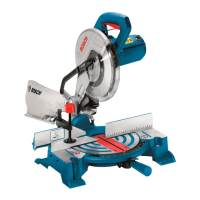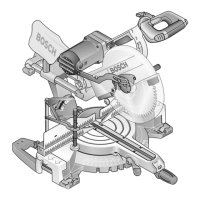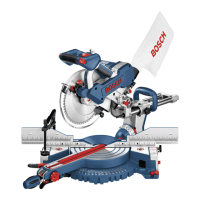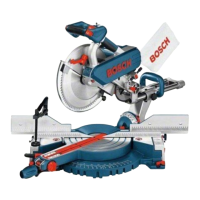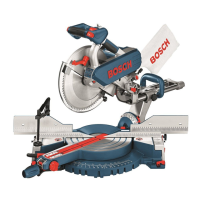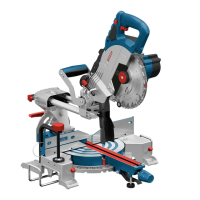English | 17
Only saw materials which are permitted within the scope of
the intended use.
Position of the operator (see figure L)
u Do not stand in line with the saw blade in front of the
power tool. Always stand to the side of the saw blade.
This protects your body against possible kickback.
– Keep hands, fingers and arms away from the rotating saw
blade.
– Do not reach one hand across the other when in front of
the tool arm.
Permissible workpiece dimensions
Maximum workpiece dimensions:
Mitre
angle
Bevel
angle
Height x width [mm]
at max. height at max. width
0° 0° 89 x 89 62 x 130
45° 0° 86 x 67 65 x 91
0° 45° 44 x 95 32 x 130
45° 45° 44 x 67 32 x 91
Minimum workpiece dimensions (= all workpieces that can
be secured left or right of the saw blade using the supplied
quick-action clamp ): 110 x 130mm (length x width)
Max. cutting depth (0°/0°): 89mm
Replacing insert plates (see figure M)
The insert plate (9) can become worn after long use of the
power tool.
Replace faulty insert plates.
– Bring the power tool into the work position.
– Unscrew the screws (46) using the cross-headed screw-
driver (22) provided and remove the old insert plate.
– Screw the insert plate as far as possible to the right with
the screws(46) so that the saw blade does not come into
contact with the insert plate over the entire length of the
possible cutting motion.
Sawing (cutting)
– Firmly clamp the workpiece as appropriate for its dimen-
sions.
– Set the required mitre and/or bevel angle.
– Set the height of the adjusting screw (30) so that the
workpiece can be sawn through completely.
– Switch the power tool on.
– Push the lever (2) and slowly guide the tool arm down-
wards using the handle (3).
– Saw through the workpiece applying uniform feed.
– Switch off the power tool and wait until the saw blade has
come to a complete stop.
– Slowly guide the tool arm upwards.
Adjusting the depth stop (sawing the groove) (see figure
N)
The adjusting screw (30) of the depth stop has to be turned
clockwise if you want to saw a groove.
– Swivel the tool arm by the handle (3) into the position at
which the required groove depth is reached.
– Turn the adjusting screw (30) clockwise until the end of
the screw touches the housing stop.
– Slowly guide the tool arm upwards.
Special workpieces
When sawing curved or round workpieces, these must be es-
pecially secured against slipping. At the cutting line, there
should be no gap between the workpiece, fence and saw
table.
If necessary, you will need to manufacture special fixtures.
Working on mouldings
Mouldings can be sawn in two different ways:
Positioning of
workpiece
Base moulding Crown moulding
– Placed against
the fence
– Lying flat on the
saw table
Always check the set mitre and/or bevel angle first by mak-
ing trial cuts in scrap wood.
Checking and Adjusting the Basic Settings
To ensure precise cuts, the basic settings of the power tool
must be checked and adjusted as necessary after intensive
use.
Experience and suitable special tools are required for this.
A Bosch after-sales service point will handle this work
quickly and reliably.
Aligning the fence
– Bring the power tool into the transport position.
– Turn the saw table (7) to the 0° detent(45). The lever
(11) must be felt to engage in the detent.
– Pull the adjustable fence (17) all the way out.
Checking (see figure O1)
– Set an angle gauge to 90° and position it flush with the
saw blade (41) between the fence (6) and the saw blade
on the saw table(7).
The leg of the angle gauge must be flush with the fence over
the complete length.
Setting (see figure O2)
– Loosen all hex socket screws (47) with the hex key (22)
provided.
– Rotate the fence (6) until the angle gauge is flush over the
complete length.
– Re-tighten the screws.
Setting the Standard 0° Bevel Angle
– Bring the power tool into the transport position.
Bosch Power Tools 1 609 92A 4YM | (15.05.2019)
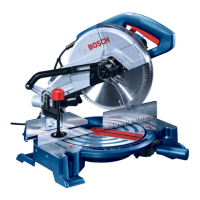
